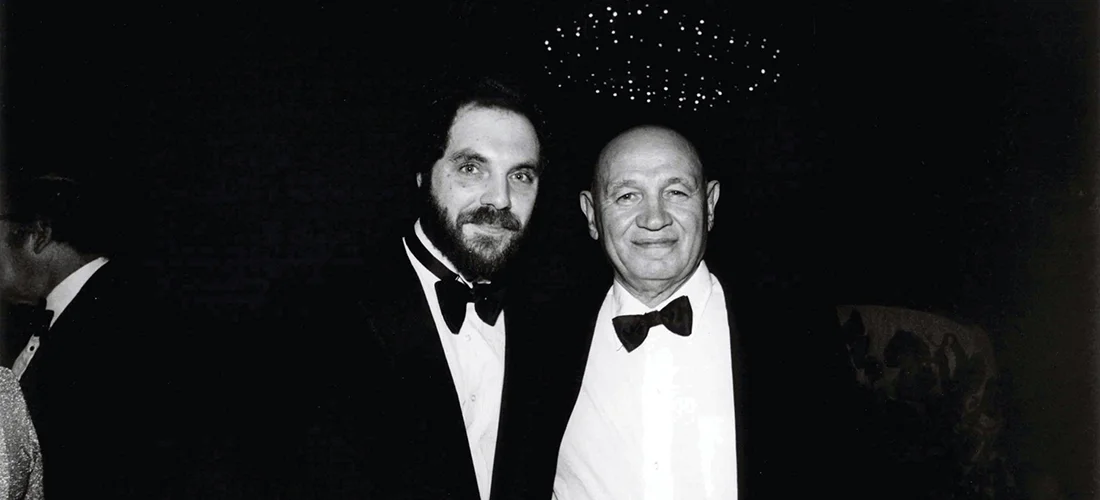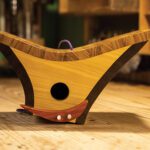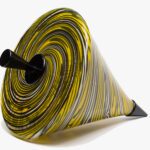An artful life
April 26, 2024

As his gallery celebrates a milestone, Jerald Melberg reflects on 40 years of friendship, fortune and fine art.
by Cathy Martin
In recent years, I’ve had several opportunities to sit down and chat with Jerald Melberg at his Charlotte art gallery. Galleries like this, where some of the finest works can fetch six figures, can be intimidating. Jerald, his wife Mary and their staff have always made me feel at ease.
After several years working as a curator at the Mint Museum in the 1970s, Melberg opened his eponymous gallery uptown in 1983. At the time, Charlotte had no fine art galleries — at least none showcasing artists of the caliber that Melberg’s did — Pablo Picasso, Romare Bearden, Robert Motherwell, Wolf Kahn and Dale Chihuly among them.
This year, the Cotswold gallery is celebrating its 40th anniversary, and again I met with Jerald to talk about the milestone moment. Despite his success over four decades as a gallery owner, Melberg, 75, still seems slightly bewildered by it all.
“Don’t some people have thoughts about what they’ve done and how they’ve done it, and has it been worthwhile?” he ponders. “Are you real — am I real? I get philosophical, and I get a little maudlin,” he chuckles.
Then the confidence returns. “I love what I do. I don’t want to sound or even be braggadocio. But damn it, I like to think in 40 years I’ve contributed something to this community.”
Melberg started his gallery long before the Bechtler or Mint Museum Uptown existed — when the Mint on Randolph Road was the museum. When the Mint was set to close for a yearlong expansion project, a museum patron pointed out the auspicious timing. “She said, Jerald, I think Charlotte is ready for a good gallery,” he recalls. “And I think you’re the one who should do it.”
He started the same way many small business owners did in the pre-internet era. “I went to the chamber of commerce, and I got every pamphlet and book on how to start a small business,” Melberg says.
Over the years, amid much hard work, some things simply fell into place — like the time a friend attending a private gathering at the gallery casually mentioned that his best friend was president of the Dedalus Foundation, the custodian of Robert Motherwell’s art. The connection quickly led to a New York meeting between Melberg and foundation president Richard Rubin.
“I left there, and I got on the elevator, and I am on cloud nine — I have just become the representative of the Robert Motherwell foundation,” Melberg says. “Twelve floors later, when I got off the elevator, I could hardly move my feet… I went from elation to scared to death.”
Given the gallery’s reputation and track record, he needn’t have worried. To mark its 40th anniversary, the gallery will present an exhibition of works by all of the gallery’s 26 artists. The exhibition debuts with a preview and party on the evening of May 3, followed the next day with a Coffee & Conversation, where the artists will interview Melberg about his career. It concludes June 28.
The following are excerpts from my conversation with Jerald Melberg. Comments have been edited for length and clarity.


Left: Jerald Melberg, photograph by Richard Israel. Right: Photograph courtesy Jerald Melberg Gallery.
I came up with the idea. I literally went to people’s homes that I knew. I’d sit there at seven o’clock on a Tuesday night, and I’d say, I have a business plan that I wrote. Here’s what I want to do. Here’s how I want to do it. Can you see a way to give me $20,000 to help me get started? A loan. And at the time, $20,000 was a lot of money — it’s still a lot of money.
My goal was to raise $100,000. And we set it up so that people would put in half of their commitment at the beginning, 25% six months later, and 25% six months later, so the gallery would have two booster shots. I was able to raise $87,000 — and fish or cut bait, we went fishing. I never took a second payment. I never took any of the third payments. Within one year, I had bought everybody out and they made 40 cents on the dollar profit.
I was able to put together the very first Picasso show in North Carolina in 1984. It took a lot of work. Going to Geneva, where [the works were] stored and seeing these racks of paintings was an astonishing experience. When I knew it was all solid, I called [Charlotte Observer art critic] Richard Maschal. I brought him this press release and a whole packet and said, we’re going to do this monster Picasso show — first time in North Carolina. And I’m giving you the scoop. He thought it was fabulous — he was very excited. So the next morning, I went to get a paper. I started paging all the way through to the end of the sports section and found nothing. I was so crushed; I was so disappointed. And then I put the paper down and realized it was on the front page under the fold.
My proudest moment is the time when I was invited to be the godfather of the first graduating class at the Charlotte school in Arequipa, Peru. If I were to leave a legacy at all, for me, it would be the kids and my work with school. I’ve been to Peru over 30 times. We started with a one-room school that was just concrete brick, tin roof. The kids sat on a concrete block and held a piece of wood in their lap. They went to school in three-hour shifts, three different shifts. The kids had to leave their pencil behind for the next student.
Arequipa is the second largest city in Peru after Lima. It has been Charlotte’s sister city for over 60 years. I was asked by the Charlotte Sister Cities committee to help them organize a show of artists from Arequipa in Charlotte. That’s how I started. I’d never heard of Arequipa — I couldn’t pronounce it. I didn’t know how to spell Arequipa.
I have been so proud to be involved. I’ve done fundraisers at my gallery. We now have a 30-classroom elementary school. We have a technical high school, a cafeteria, a kitchen. A couple of years ago, we installed solar panels on the roof of two of the buildings. We’ve gone from a piece of wood in your lap to a computer lab in 30 years.
I have been most fortunate to be able to mount exhibitions for some enormously important artists. I did a massive Romare Bearden exhibition at The Mint. It was a decade-long retrospective. That was all finished, and I was in New York having lunch with Bearden. And I said, Romie, I need to tell you that I’m going to be leaving the museum. And he said, Well, I’ve already heard. And I said, well then you probably know that I’m planning to open a gallery in your hometown, and Romie, I would be so honored if I could represent you. And he looked across the table, and he said, I was going to be so disappointed if you did not ask.
What I love: I make a sale — yes, that’s great. For me, all that does is give me the opportunity to do what I’m doing again tomorrow. Because I take joy in seeing people’s faces. I take joy in having a client look at me and say, Jerald, I don’t know if I should love you or hate you. I think that’s a great compliment.
I’m so fortunate that I’ve been able to meet so many incredible people. And how many of them — incredible artists, incredible collectors — have become good friends. I have one guy, he comes in here frequently just to kick around to see what’s going on. He doesn’t come to my office to say hello. He comes back here where the liquor cabinet is and makes himself a bourbon. Then he goes to find me. Which is great — I love it.
I have a small group of artists that I believe in and I’ve continued to promote. It’s not, for me, about what they make. What I mean is it doesn’t matter if they’re representational or abstract. If they speak to me, and I think they are terrific artists, that’s what matters. It’s the emotional response. If that’s there for me, then I can convince others and I can sell it.
Recently, about a year ago, we added an artist, a very significant and important artist, Donald Sultan. I’ve always admired his work. I just decided one day I’d call him up. A week later, Mary and I were going to be in New York, so I went to see him. We’re sitting at a table in his studio. I started my pitch about who I am… and he stopped me. He said, Jerald, I’ve known who you are for years. I’ve just been waiting for you to call me. I’m still learning these lessons — that I can reach out, it’s OK. And he’s become an excellent addition to the gallery.
I have never thought of giving it up. I’m still enjoying it. I have things to do. I used to get to the gallery by 7:30 or 7:45, and I’d go all day long. These days, if I decide to have a second cup of coffee and sit on the deck at 9:30 because it’s a beautiful morning, I have a great staff. And I think that maybe, I’ve deserved that. And they think so, too. Sometimes I can’t go the way I used to go, but I’m still in the game. I still want to be in the game. It’s important to me what we’re doing. SP
Featured image: Jerald Melberg and Romare Bearden at The Mint Museum in 1980. Photograph courtesy Jerald Melberg Gallery





